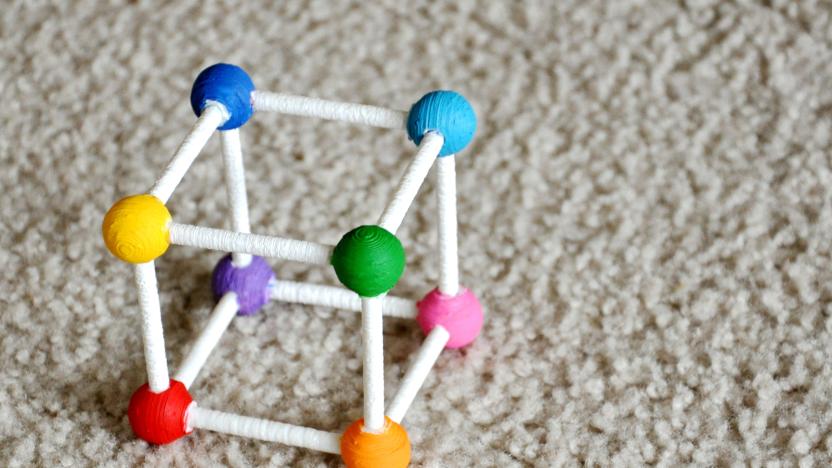ncsu
Latest

Soft robots can now run like cheetahs and swim like marlins
The days of sedate soft robots could soon come to an end thanks to a novel robo-spine developed by researchers at North Carolina State University.

This colorful cube grounds virtual objects in the real world
You can't usually spin, stretch and otherwise manipulate virtual objects all that easily. You're often relegated to clicking and dragging on a mouse, and even exotic approaches like HoloLens or VR headsets introduce issues like lag. However, North Carolina State University has developed a simple solution that only requires a webcam and a little geometry. Their Captive technology revolves around a color-coded cube that sends visual cues to video recognition software -- all you have to do is rotate the cube to examine a virtual object, resize it or change textures.

Atom-thin water layers may lead to faster electric cars
So many battery breakthroughs focus on longer battery life (and for good reason), but what about the speed of delivering that energy? That's what North Carolina State University researchers want to solve. They've produced a material, crystalline tungsten oxide hydrate, that uses atom-thin water layers to tune electrical charge transfers for speed. When the team uses this material in a pseudocapacitor (which stores energy by transferring charges between electrodes and electrolytes), the result is a battery that theoretically represents the best of two worlds. It has the high energy density you'd expect, but it's also very quick at shuttling ions back and forth. That, in turn, could lead to performance breakthroughs in devices where rapid power is at least as important as raw capacity.

Scientists control soft robots with magnetic fields
As slick as soft robots are, they tend to have very simple movements. It'd be a challenge to create a truly complex machine using existing technology. Researchers may have a solution to more sophisticated movement, though. They've invented a technique that uses magnetic fields to steer squishier robots. The trick was to cover the robots in a polymer film loaded with iron microparticles made to form parallel chains using a magnetic field. When you want to steer a robot, you just subject its relevant components to another magnetic field -- the direction and strength of the field determines what happens.

National Academy of Sciences finds GMOs to be 'safe'
The debate surrounding the safety of genetically modified organisms (GMOs) has been raging for years and continues to do so. The National Academies of Sciences, Engineering, and Medicine has finally weighed in on the matter and found GMOs to not just be generally safe, but good for both people and the environment. The academy has even gone so far as to set up a dedicated website where visitors can peruse the source data that the academy leveraged for its study.

Engadget Daily: Lumia 930 review, remote-controlled moths and more!
Today, we visit Seattle's Living Computer Museum, go hands-on with the Lumia 930, ponder remote-controlled moths, learn about Sony's plan to reclaim "20 lost years," and more. Read on for Engadget's news highlights from the last 24 hours.

NC State develops personalized web search without the usual server strain
The notion of personalized, contextually aware search is nothing new, but it can put a tremendous strain on servers by asking for a lot of data at once. NC State has developed a search technique that could ease that burden. Its code prioritizes results based solely on the "ambient query context," or the concepts related to a person's recent search history. Look for politicians, for example, and a search for Ford is more likely to bring up Gerald Ford than the car company. By focusing on just a fraction of a user's search habits, the university can customize results using far fewer processor cycles: while a test server could only handle 17 active searchers with an old approach, it can manage 2,900 with the new method. The query engine won't be confined to the lab, either. NC State tells us that a community-driven search beta is due within several months, and there are plans to commercialize the technology in the long run.

Injectable 'smart sponge' controls diabetes, presents new targeted drug delivery method
Diabetics might appreciate high-tech glucose sensors when they're available, but the option for other advanced treatments is certainly intriguing. Take, for example, this new method developed by North Carolina State University researchers that uses injectable sponge to control blood sugar levels. No, it's not the same sponge you use to clean at home -- the material is made out of a substance taken from crab and shrimp shells called chitosan. This spongy material forms a matrix that's approximately 250 micrometers in diameter, where a rise in blood sugar causes a reaction in the pores that leads to the drug's release. Fighting diabetes is but one of the things this miraculous sponge can be used for; developed further, it could even "intelligently" release anticancer drugs whenever the chitosan reacts to tumors or cancer cells in close proximity. Seems like medical technology is getting smarter with each passing day.

Liquid metal for 3D printing could lead to bendy electronics, T-1000
3D printing is awesome, yet it still has a lot of untapped potential -- you can use it to create terrifying spiderbots and even tiny drones, but you can't make electronic components out of pools of plastic. Thankfully, a team of North Carolina State University researchers have discovered a mixture of liquid metal that can retain shapes, which could eventually be used for 3D printing. Liquid metals naturally have the tendency to merge, but alloys composed of gallium and indium combined form a skin around the material. This allows researchers to create structures by piling drops on top of each other using a syringe, as well as to create specific shapes by using templates. The team is looking for a way to use the mixture with existing 3D printing technologies, but it might take some before it's widely used as it currently costs 100 times more than plastic. We hope they address both issues in the near future, so we can conjure up futuristic tech like bendy electronics, or maybe even build a body to go with that artificial skin.

Smile, and JavaTutor's AI knows when you're learning online
College-age kids these days are pretty good at a few things: selfies, social oversharing and staring into screens. But can you leverage that self-obsession into a mechanism for learning? The mad scientists at North Carolina State University think so and they've got a program to prove it. Dubbed JavaTutor, the software's aimed at teaching our future workforce the basics of computer science. And it does this by tracking facial expressions -- using the Computer Expressions Recognition Toolbox, or CERT, as its base -- during online tutorial sessions. Frown and the AI knows you're frustrated; concentrate intently and the same automated emotion detection applies. So, what's the end sum of all this? Well, it seems the research team wants to gauge the effectiveness of online courses and use the cultivated feedback to better tailor the next iteration of the JavaTutor system. But the greater takeaway here, folks, is that at NCSU, online tutoring learns you!

Mad scientists turn roaches into cyborgs, control them with Kinect, laugh at nature
We'd love to tell you that the researchers at North Carolina State University aren't monsters who implant circuits on living things so that those living things do their bidding, but we'd be lying. They totally do that, roaches are their primary victim, and now they're using Microsoft's Kinect to help them control the insects. Sure, why not! As Dr. Alper Bozkurt of NCSU says in today's new release, "Our goal is to be able to guide these roaches as efficiently as possible, and our work with Kinect is helping us do that." Apparently the researchers are employing Kinect for data collection as well, determining how effectively the cyborg survivors respond to electrical impulse-motivated control. They say the end goal is to use the partially mechanized arthropods to, "explore and map disaster sites." For now, there's some very weird stuff happening in North Carolina. Head below for a video of the roaches in action.

NC State builds stretchable wires from liquid metal, keeps headphones humming (video)
More than a few of us have had that moment of panic when our headphone cords catch on an object and cut the listening short -- sometimes permanently. Researchers at North Carolina State University could help mitigate those minor musical catastrophes with wiring that stretches up to eight times its normal length. The method fills an elastic polymer tube with a liquid gallium and indium alloy that delivers the electricity. By keeping the materials separate, unlike many past attempts, the solution promises the best of both worlds: the conduction we need, and the tolerance for tugs that we want. NC State already has an eye on stretchable headphone cords, as you'll see in the video after the break, but it also sees advantages for electronic textiles that could endure further abuse. As long as the team can eventually solve a problem with leakage when there's a complete break, we'll be glad enough to leave one of our common audio mishaps in the past.

Android 4.2 App Verification Service tested, found no substitute for full anti-malware tools
Google's App Verification Service is a quiet addition to Android 4.2, but potentially game-changing: it promises malware checks for any installable Android app, whether it comes from a Bouncer-verified Google Play or a website lurking in the shadows. NC State University Associate Professior Xuxian Jiang doesn't want to simply accept the claim at face value, though. He just pitted the service against 10 anti-malware apps to gauge its effectiveness at stopping a wide range of rogue code. The short summary? Don't quit your day job, Google. Among 1,260 samples, the App Verification Service caught 193 instances, or 15.32 percent -- well below the 50 percent of its closest challenger, and nowhere near the perfect scores of two apps. According to the professor, Google's shortcoming mostly comes from a relatively skin-deep routine that checks the SHA-1 value and install package name, not underlying code that's tougher to change. Android malware isn't a serious enough issue for us to be worried at present, but nor would we lean on the App Verification Service as our only safety net.

NC State nanoflowers can boost battery and solar cell capacity, make great prom accessories
We see a lot of sleek-looking technology pass through our doors, but it's rare that the inventions could be called beautiful by those who aren't immersed in the gadget world. We'd venture that North Carolina State University might have crossed the divide by creating an energy storage technology that's both practical and genuinely pretty. Its technology vaporizes germanium sulfide and cools it into 20-30 nanometer layers that, as they're combined, turn into nanoflowers: elegant structures that might look like the carnation on a prom dress or tuxedo, but are really energy storage cells with much more capacity than traditional cells occupying the same area. The floral patterns could lead to longer-lived supercapacitors and lithium-ion batteries, and the germanium sulfide is both cheap and clean enough that it could lead to very efficient solar cells that are more environmentally responsible. As always, there's no definite timetable for when (and if) NC State's technology might be commercialized -- so call someone's bluff if they promise you a nanoflower bouquet.

NCSU creates stretchable conductors from silver nanowires, lets gadgets go the extra inch
As often as we've seen flexible electronics, there haven't been many examples that could stretch -- a definite problem for wearables as well as any gadget that could afford to take a pull or squeeze. North Carolina State University's Yong Zhu and Feng Xu may have covered this gap through a form of silver nanowire conductor that keeps the energy flowing, even if the wire is stretched as much as 50 percent beyond its original length. By coating the nanowires with a polymer that traps the silver when solid, the researchers create an elastic material that can crumple and let the nanowire take the strain without interruption. Although the stretchy conductor's nature as a research project could put any practical use years into the future, Zhu notes that it can take loads of abuse, making it a perfect fit for rugged mobile devices. It should also allow for robots with a gentler touch and a more natural look... although we'll admit we're skittish about the creepy androids likely to follow.

Mobile security researchers present Android Malware Genome Project at IEEE
Android's openness, combined with its popularity, has lead a few of the developer faithful astray -- with malware being a legitimate concern for the mobile operating system. To help combat the issue, Xuxian Jiang, an NC State researcher, has created the Android Malware Genome Project, which was presented at the IEEE Symposium on Security this week. The aim is to collect and analyse all the known malicious software, and share the findings so that more effective and preventative measures to be taken by the community. Jiang claims that the main drawback has been understanding the malware, and getting access to examples, something the project aims to solve. More than 1,200 malware samples have been collected so far, and if you're curious, the dataset is available for download via the source.

Android study finds privacy and security risks related to in-app advertising
Android has certainly taken heat for malware-related bits in the past. Now, a recent study by computer scientists at North Carolina State University reveals that over half of the 100,000 apps from the Android Market Google Play include so-called ad libraries, which are essentially handed out by Google or third-party devs to retrieve ads from servers and launch them on your phone. Of these, 297 were classified as "aggressive," as they're allowed to run code from a remote server. Furthermore, Dr. Jiang along with his squad of researchers found that more than 48,000 of the apps put to the test could track location via GPS, while other accessed info could range from call logs, contact numbers, to the apps list on your device. It's unclear if this also applies to Android slates, though this particular study conducted only included handsets.

Researchers get CPUs and GPUs talking, boost PC performance by 20 percent
How do you fancy a 20 percent boost to your processor's performance? Research from the North Carolina State University claims to offer just that. Despite the emergence of fused architecture SoCs, the CPU and GPU cores typically still work independently. The University hoped that by assigning tasks based on each processor's abilities, performance efficiency would be increased. As the CPU and GPU can fetch data at comparable speeds, the researchers set the GPUs to execute the computational functions, while the CPUs did the prefetching. With that data ready in advance, the graphics processor unit has more resources free, yielding an average performance boost of 21.4 percent though it's unclear what metrics the researchers were using. Incidentally, the research was funded by AMD, so no prizes for guessing which chips we might see using the technique first.

Scientists make magic auto-origami using ink and light (video)
We've seen nano-origami and robo-origami, but nothing quite as rapid and simple as this. Researchers at North Carolina State University have figured out how to neatly fold plastic using infrared light and an inkjet printer. Deep black lines are printed onto the plastic sheets, which then absorb the light and cause the material to fold without anyone having to touch it. The wider the line, the greater the angle of each fold, so it's possible to set, say, a 90-degree bend for a cube or 120 degrees for a pyramid. What's more, by giving the lines different patterns, folds can be made to work in specific directions, potentially producing the most perfect, most hygienic bento box that's ever contained your lunch. Click past the break to watch the folding unfold.

Researchers develop method to measure effects of WiFi attacks
America is built on the principles of life, liberty and WiFi, the latter of which has increasingly become a target for hackers hoping to mess up our chi. To predict what would happen as result of an assault, researchers at North Carolina State University created two models -- one based on a continuous jam of service, and one on an intermittent disruption that would cut off service during specific times. They then measured "order gain," which compares the probability of an attacker having network access to the probability of a legitimate user having access. Basically, the more control a hacker has, the more regular users that will lose service and be shut out -- making it harder to regain control. Researchers hope the new method will help identify the most vulnerable networks, opening the doors to create effective countermeasures to keep our WiFi safe -- something that Starbucks customers will surely be thankful for.









